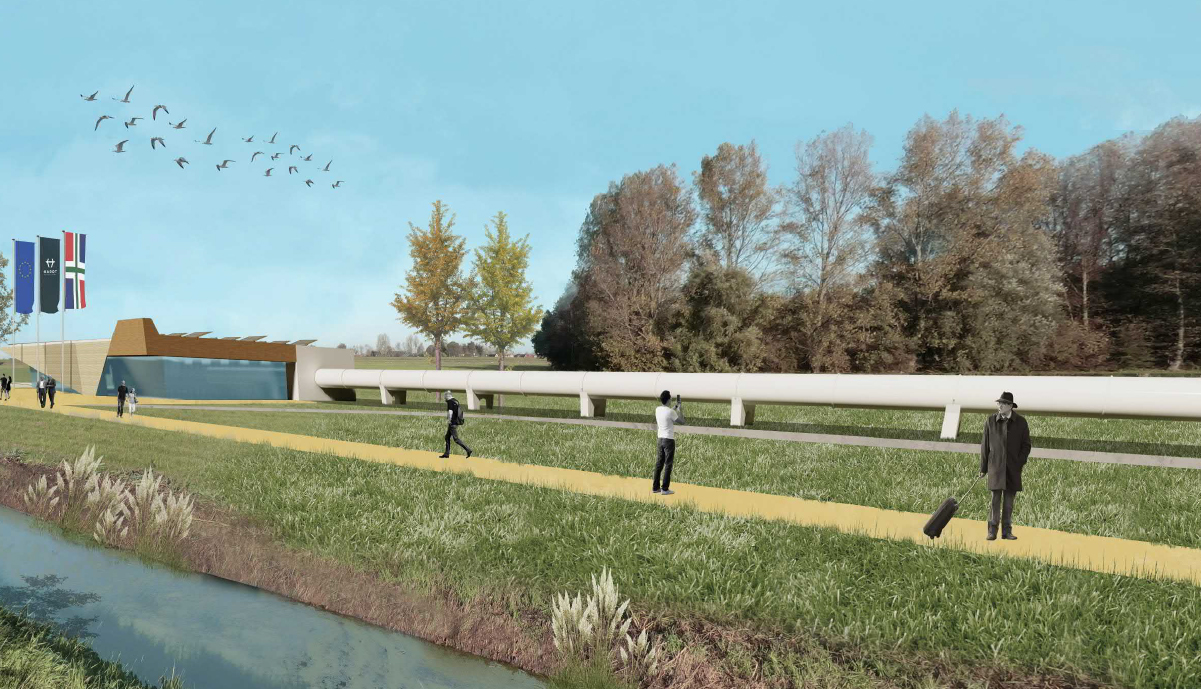HARDT and Delft Hyperloop are part of a consortium that is setting up a hyperloop development centre in Groningen with a budget of more than EUR 30 million.
Design for the European hyperloop centre near Groningen. (Drawing: Municipality of Groningen)
Five years after a TU Delft student team first took part in the SpaceX hyperloop competition, the hyperloop’s development is now gaining momentum. Hyperloop started in 2013 as an idea of the visionary entrepreneur Elon Musk who imagined a scaled-up pneumatic tube as the transport system of the future: as fast as an aeroplane, as ecological as an electric train. That was the start of a global competition with the finals in SpaceX’s backyard in Los Angeles. The European Hyperloop centre that is now to be built in Groningen should be the first step in a European hyperloop network, about which there is a video (about one minute).
Ministries and industry are investing millions in hyperloop development, the company Hardt announced at the end of last month. At the same time, the creation of the public-private Hyperloop Development Program (HDP) consortium was announced, as was the construction of the European Hyperloop Center (EHC) in 2022 (see video, about one minute). At the heart of the research centre is a test track of 2,650 metres in length with a diameter of just under two metres.
The aim of the research programme for the next three years is to:
- demonstrate the feasibility of the hyperloop as a safe and sustainable form of transport for people and goods;
- test the technology developed in the EHC and demonstrate safe operation; and
- explore opportunities for industry and shareholders in the future hyperloop ecosystem.
The development programme has a target budget of EUR 30 million. Most of this (EUR 22.5 million) has been pledged by the member companies, mostly in goods and services. The Ministry of Infrastructure and Public Works and the Ministry of Economic Affairs and Climate are each contributing EUR 4.5 million. In addition, EUR 3 million comes from the province of Groningen for the construction of the European Hyperloop Center, a few kilometres east of the city of Groningen (download study here).
Does this mean the end of the hyperloop development at TU Delft? According to Juliette de la Rie (Hardt) and Pieter Becking (Delft Hyperloop) this is not the case. Hardt will largely remain in Delft but will use the track in Groningen for testing. The Delft Hyperloop student team will take part in the European Hyperloop competition in the coming years and plans to take the competition to the Groningen track in 2023. There are other hyperloop test tracks in the planning or under construction, such as in Toulouse, Valencia and Wallis (Switzerland), but for the time being, the Groningen design has the longest track.
Large steps have been made in the hyperloop development, including in electromagnetic propulsion (video link), magnetic suspension and contactless points. A tricky problem is still the transition between the vacuum inside the tube and the atmospheric pressure outside. Different types of airlocks will be tested in Groningen.
In addition to the aforementioned ministries and the Province of Groningen, the following parties are involved in the programme: ADSE, Balance, Royal BAM Group, Beckhoff, Delft Hyperloop, EuroTube, Hochschule Emden/Leer, Hardt, Institute of Global Innovation Economics and Logistics, Royal IHC, NEVOMO, NS, POSCO, Recaro, Royal Schiphol Group, Schweizer Design Consulting, Tata Steel, TÜV Rheinland and Vattenfall.
Do you have a question or comment about this article?
j.w.wassink@tudelft.nl


Comments are closed.